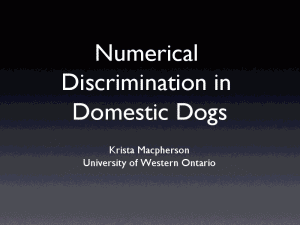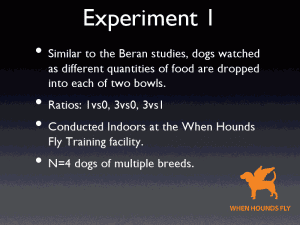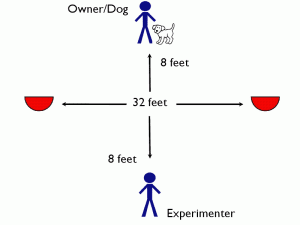Hello Readers –
Did you know that Krista Macpherson, a researcher from the University of Western Ontario, conducts canine cognition research at When Hounds Fly? Many of her test subjects are current and past students! Here is an update she sent out to past test participants, including a deck she presented at a conference with interim findings back in March.
Want to volunteer your dog and your time? Please email krista.macpherson@gmail.com and mention if you are (or aren’t) a student (current or past) at school. She is always looking for volunteers to help.
——————–
From Krista:
Hi all!
First of all, my apologies for not following up with you all sooner…I keep telling myself “I’ll talk about results once I have collected a bit more data”…but of course I’m always collecting a bit more data, so I might as well talk about results now!
Most of the people on this email list have participated in one (or both) of two experiments…the first was a timing experiment, and the second was a counting experiment…I’ll speak to the progress of each study below:
Timing Experiment
In this experiment, we had one or two “Manners Minder” machines spit out a a treat on a set interval (either every 30 seconds, or every 1 minute). With this study, we were interested in determining whether over time, the dogs would come to anticipate the arrival of food from the machines, and thus approach the machine as the time interval approached. This ended up being problematic, because most of the dogs easily figured out that the ideal solution was simply to lay beside the machine the entire time and wait for the snacks! While this was a good strategy on the dogs’ part, it made it impossible to measure timing in terms of proximity to the machine.
Luckily, the psychology department at Western has a great team of woodworkers and electricians to build experimental materials…and they have revamped the Manners Minder machine for me. It is now bolted to a plank of wood, and has a large button hooked up to it. So the dogs will still be able to get the food at a set interval…they’ll just have to hit a button first. This means that instead of measuring timing in terms of the dogs’ proximity to the machine, we can measure timing in terms of the number of button presses that occur as the interval approaches. I’m going to start pilot testing this new apparatus in the next couple of weeks!
Counting Experiment
With the counting experiment, dogs watched as the experimenter (me) dropped different quantities of food into each of two bowls. If dogs can count, then they should reliably choose the bowl with the larger quantity of food. What we found is that when the food ratio involves “food versus no food” (which in this experiment, was done using 3 versus 0 pieces of food , and 1 versus 0 pieces of food) the dogs are extremely good at the task (in fact, they rarely choose the wrong bowl. In any other combination (e.g. 1vs3, 4vs1, 2vs3, 3vs4, 2vs1) the dogs really struggle with this task, and to get right answer only about 60-65% of the time (and since there are only two bowls, chance performance is 50% on this task).
It is interesting that dogs struggle on the counting task, because pretty much any other species tested on this task has performed quite well at it. A couple reasons that they may not be good at this task are as follows:
1. As we have selectively bred dogs to attend to us (herd our sheep, guard our homes etc.), we might have “bred out” other characteristics that were more important for survival in the wild, like numerical discrimination.
2. Dogs are dumb (I personally am not a fan of this explanation!).
Another possibility is that this procedure, for whatever reason, was not “meaningful” to the dog. In talking to another researcher who was working on a similar project, is occurred to me that I have always had the experimenter drop the food into the bowl, while the owner held the dog (but did not otherwise interact with the dog). What if the owner was the one to drop the food into the bowls? Would the dog pay more attention to the task?
Long story short, I changed the procedure so that the owner was the one dropping the food into the bowls–and preliminary results show that in many cases this made a big difference to the dogs. We need to test this more formally, but these initial findings are really exciting!
I presented the counting data (minus the new “owner dropping the food” version of the experiment) at a conference in Florida in March, and it was very well received. I have attached a copy of the slides that I presented, for any of you who may be interested.
Upcoming Projects
I am currently looking for some more dogs to do more counting studies with–I need naive dogs, who have never done this task before. If you have a dog or know someone who has a dog who would like to participate, please let me know! I will be running sessions at When Hounds Fly on April 30th/May 1st, as well as May 14th/15th, between 2pm and 7pm. It takes about an hour to complete the experiment.
As always, many thanks for all of your help with these projects!
Krista
Want to see the slide presentation? Click on any of the images below:



